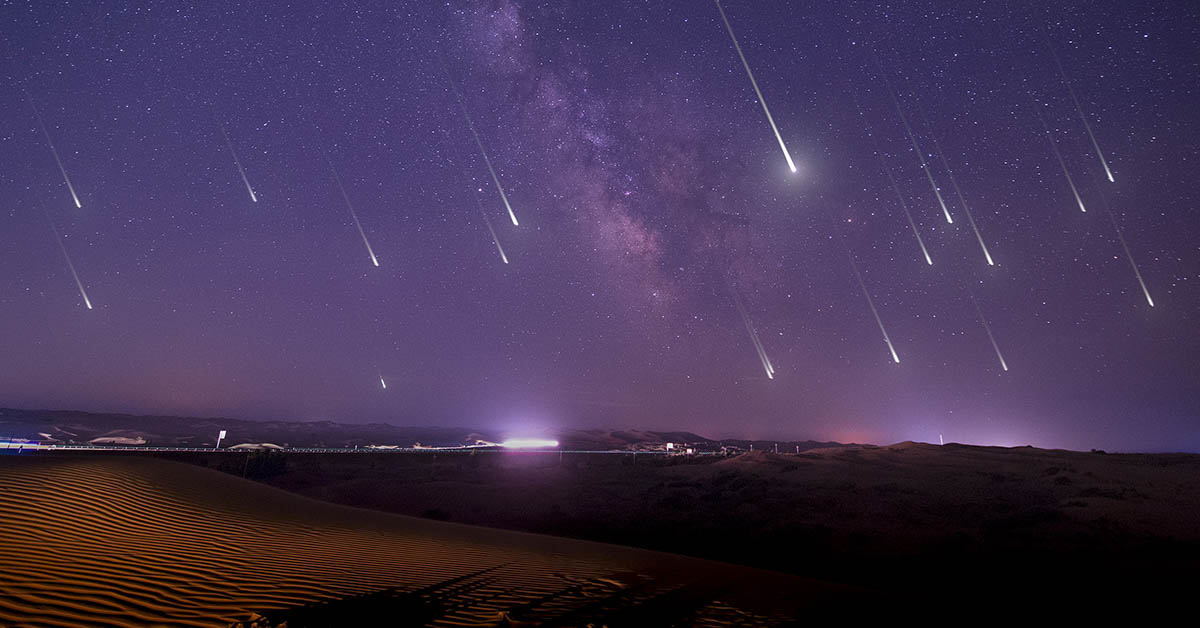New year, new opportunities for sky-gazing. If you are new to astronomy or an old pro, there are many celestial events to kick off 2023, including a meteor shower, a comet, and clear sightings of planets and star clusters. Some of these events require special equipment, like a telescope or binoculars. Plus, a sky map or app can help you find celestial events based on your geographic location. But some upcoming events are visible with the naked eye. So find a location with minimal light pollution, spread out a blanket, and enjoy the view.
January’s First Event: The Quandrantid Meteor Shower
This week, the night sky features the Quandrantids, one out of the dozen of meteor showers that occur every year. This celestial event is usually among the strongest of showers and is likely to peak on January 3rd and 4th, according to the American Meteor Society, which is when people in the Northern Hemisphere are more likely to catch the best view of the event. But keep in mind, this meteor shower is often hard to spot since it usually peaks for six hours and January has harsh and fickle weather. Additionally, a bright moon can worsen the visibility of the Quandrantids, which gives a very small window to catch a glimpse of the shower. However, this celestial event won’t be visible in the Southern Hemisphere.
Quandrantids are among the brightest annual meteor showers, since they are made of rock from an asteroid while other showers are made of ice from a comet. Still, it’s advisable to drive out of urban areas to somewhere with limited light pollution to view celestial events. An open place without any artificial lights could provide a beautiful display of meteors throughout the night. Give your eyes about 20 to 30 minutes to adjust to the darkness, so avoid looking at phones or other screens while you wait. [1]
This meteor shower was named after the constellation Quadrans Muralis. It was first noted in 1795 but it has since been deemed obsolete and excluded from the International Astronomical Union’s list of modern constellations. If you miss the Quandrantids, there are many more meteor showers expected this year. The Geminid meteor shower also consists of an asteroid instead of the typical icy comet. Here are the dates to look out for:
- Lyrids: April 22–23
- Eta Aquariids: May 5–6
- Southern delta Aquariids: July 30–31
- Alpha Capricornids: July 30–31
- Perseids: August 12–13
- Orionids: October 20–21
- Southern Taurids: November 4–5
- Northern Taurids: November 11–12
- Leonids: November 17–18
- Geminids: December 13–14
- Ursids: December 21–22
More Celestial Events in January 2023
January 8 – The main belt asteroid designated Pallas will reach opposition. Meaning, the asteroid will be bright and visible all night with the help of binoculars and telescopes around sunrise and sunset. But the naked eye may catch sight of it in the late evening.
January 12 – Comet C/2022 E3 (ZTF) will likely brighten as it grows close to the sun. Its visibility might improve until February 1, when it will be closest to the Earth. You can track its approach with this finder chart. [3]
January 16 – The Pleiades open star cluster will be positioned high in the southern sky. This star cluster is also known as the Seven Sisters and Messier 45, and the constellation Taurus will be visible below it. The Pleiades are made of medium-bright blue stars, but only six are usually visible to the naked eye. Binoculars and backyard telescopes can pick up the rest of the hundreds of stars in the cluster.
January 21 – The new moon
It will occur when the moon is at perigee (when it’s closest to the Earth) and result in high tides around the world. For a day, no one will be able to see the moon since it will be in the same part of the sky as the sun.
January 22 – The bright planet Venus will be in close conjunction to Saturn, a paler planet in comparison. For an hour after sunset, they will shine together above the west-southwestern horizon. Binoculars and telescopes may be able to glimpse celestial events like this but wait until after sundown. People in the southern hemisphere might see the tiny moon crescent below the two planets.
January 26 – The star cluster called the Hyades, also designated Melotte 25 and Caldwell 41, will be readily visible in moonless night skies away from light pollution. Binoculars can pick up on the hundreds of stars but the naked eye could see the five brightest stars; in addition, the bright orange star Aldebaran appears at the lower vertex of the Hyades although it’s technically not part of the cluster.
January 30 – The waxing moon will appear close to Mars. Backyard telescopes may find the bright reddish dot of the planet in the southern sky. Finding the position of the moon and Mars depends on the time of night and the viewer’s geographical location. But people in the southern USA to northern South America can witness the moon cover Mars around 06:00 on January 31st.
Sources
- “The Quadrantid meteor shower: It’s January’s first celestial event.” CBS News. January 3, 2023
- “Meteor Showers Calendar 2023: Times and Dates.” Almanac. Edmund Weiss. December 30, 2022
- “10 Must-See Sky Events In 2023, From Rare Eclipses To A New Bright Comet.” Forbes. Jamie Carter. December 30, 2022
- “Night sky, January 2023: What you can see tonight.” Space. Chris Vaughan. January 1, 2023

